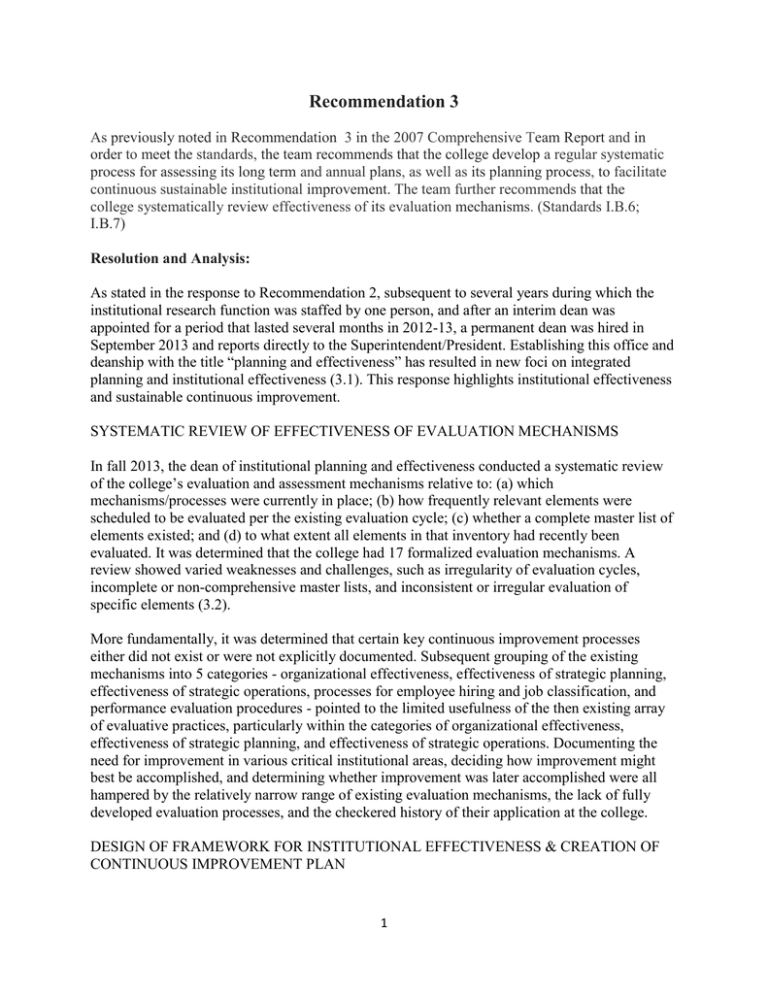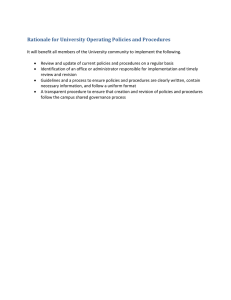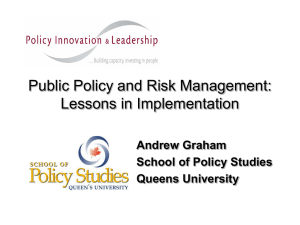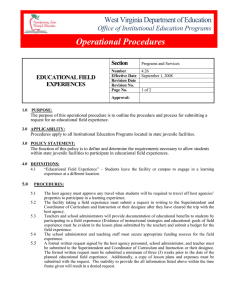Recommendation 3
advertisement

Recommendation 3 As previously noted in Recommendation 3 in the 2007 Comprehensive Team Report and in order to meet the standards, the team recommends that the college develop a regular systematic process for assessing its long term and annual plans, as well as its planning process, to facilitate continuous sustainable institutional improvement. The team further recommends that the college systematically review effectiveness of its evaluation mechanisms. (Standards I.B.6; I.B.7) Resolution and Analysis: As stated in the response to Recommendation 2, subsequent to several years during which the institutional research function was staffed by one person, and after an interim dean was appointed for a period that lasted several months in 2012-13, a permanent dean was hired in September 2013 and reports directly to the Superintendent/President. Establishing this office and deanship with the title “planning and effectiveness” has resulted in new foci on integrated planning and institutional effectiveness (3.1). This response highlights institutional effectiveness and sustainable continuous improvement. SYSTEMATIC REVIEW OF EFFECTIVENESS OF EVALUATION MECHANISMS In fall 2013, the dean of institutional planning and effectiveness conducted a systematic review of the college’s evaluation and assessment mechanisms relative to: (a) which mechanisms/processes were currently in place; (b) how frequently relevant elements were scheduled to be evaluated per the existing evaluation cycle; (c) whether a complete master list of elements existed; and (d) to what extent all elements in that inventory had recently been evaluated. It was determined that the college had 17 formalized evaluation mechanisms. A review showed varied weaknesses and challenges, such as irregularity of evaluation cycles, incomplete or non-comprehensive master lists, and inconsistent or irregular evaluation of specific elements (3.2). More fundamentally, it was determined that certain key continuous improvement processes either did not exist or were not explicitly documented. Subsequent grouping of the existing mechanisms into 5 categories - organizational effectiveness, effectiveness of strategic planning, effectiveness of strategic operations, processes for employee hiring and job classification, and performance evaluation procedures - pointed to the limited usefulness of the then existing array of evaluative practices, particularly within the categories of organizational effectiveness, effectiveness of strategic planning, and effectiveness of strategic operations. Documenting the need for improvement in various critical institutional areas, deciding how improvement might best be accomplished, and determining whether improvement was later accomplished were all hampered by the relatively narrow range of existing evaluation mechanisms, the lack of fully developed evaluation processes, and the checkered history of their application at the college. DESIGN OF FRAMEWORK FOR INSTITUTIONAL EFFECTIVENESS & CREATION OF CONTINUOUS IMPROVEMENT PLAN 1 The aforementioned empirical findings and analysis led to the decision to create a structured system of evaluation procedures, based on the identification of all key institutional continuous improvement processes as the starting point for aligning evaluation mechanisms over the timeframe of the newly developed Strategic Plan (2013-2018). The processes have been developed utilizing a template that speaks to four areas with sub-components, including: (a) the continuous improvement process, cycle and process lead; (b) participants, tasks and evidence in the evaluation process; (c) participants, tasks and evidence in making improvements in effectiveness; and (d) participants, tasks and evidence in making improvements in process effectiveness. Designing this approach to cultivating institutional effectiveness is a detailed work in progress that currently encompasses a framework of the 5 continuous improvement categories delineated above and represents 30 total processes, nearly doubling the number previously in place (17): organizational effectiveness (5), effectiveness of strategic planning (7), effectiveness of strategic operations (6), processes for employee hiring and job classification (5), and performance evaluation procedures (7) (3.3). Of these, 13 processes were determined to be especially critical to develop/further develop in the near term, as they relate directly to the accreditation recommendations requiring deficiency resolution in this follow-up report: Organizational Effectiveness Board Policies & Administrative Procedures Organizational Structure Governance System Organizational Climate Effectiveness of Strategic Planning Mission, Vision & Values Development, Review & Revision Community Research & Environmental Scanning Strategic Plan Development, Review & Revision Long Term Institutional Plans - Development, Review & Revision Comprehensive Program Review Effectiveness of Strategic Operations Annual Program Planning & Assessment Annual SLO Assessment Budget Development & Resource Allocation Performance Evaluation Procedures Board Evaluation Drafts of the above processes have been completed (3.4 through 3.16); these processes are in various stages of execution/planned implementation. All finalized templates will be included in a handbook of continuous improvement processes. More broadly, a Continuous Improvement Plan has been drafted as one of the institution’s long term plans; this plan highlights the ongoing efforts that the college intends to devote to institutional effectiveness moving forward (3.17). The draft Continuous Improvement Plan is 2 scheduled to be presented to the College Planning Council at its February 19 meeting (3.18). The handbook of all 30 continuous improvement processes will accompany, and therefore be integral to, this plan. The goal is to implement all evaluation processes starting in FY 2014-15, according to their specific cycle, and thereafter through expiration of the Strategic Plan in spring 2018. Many of these evaluation processes are already being implemented. Via systematic and consistent application of each continuous improvement process as overseen by the appropriate senior level administrator(s) and/or other leader(s), the college commits to sustainable continuous quality improvement throughout the institution, and endeavors to become a role model for other colleges in this regard. DEVELOPMENT OF SYSTEMATIC PROCESS FOR ASSESSING LONG TERM PLANS The college has developed a regular systematic process for assessing its long term plans. While each plan may ultimately require an individualized approach to the extent that key evaluation criteria differ according to plan content, the generic process is documented in a continuous improvement process focused on the review and revision of long term institutional plans (3.11). The generic process will consist of an assessment of plan implementation over the previous year, along with an evaluation of progress made toward longer term goals. Because all institutional plans must be aligned with the college’s Strategic Plan, a separate continuous improvement process was developed for its annual review (3.10), which will encompass an assessment of goals, outcomes, and key performance indicators (KPIs). A critical step prior to implementing a process for assessing long term plans was to identify which plans of the college are considered to be “long term institutional” plans. For this purpose, as stated in the response to Recommendation 2, “long term” is interpreted as multiple years, toward the ideal that a plan parallels the same years or similar period as the Strategic Plan - 2013 through 2018, and “institutional” is interpreted as having an impact throughout the college or across all divisions. The following six plans were identified as long term institutional plans in FY 2013-14; they are listed in chronological order based on their initial completion/expected completion. Title of Plan 1. Technology Master Plan 2011-2021 2. Foundation Funding Plan 2012-2017 3. Equal Employment Opportunity Plan 4. Strategic Plan 2013-2018 5. Continuous Improvement Plan 2013-2018 6. Facilities Master Plan Status Completed Completed Approved by Board 6/4/13 Approved by Board 10/1/13 Draft 2/13/14 - target completion 6/14 To be drafted - target completion 10/14 Evaluation of implementation of the Foundation Funding Plan serves as an example of annual review of long term plans. Subsequent to FY 2012-13, effectiveness was evaluated by comparing funds raised in FY 2012-13 against the funding amounts established for the entire 2012-2017 period (3.19). Tracking outcomes and key performance indicators in the Strategic Plan serves as an example of an internal reporting template that has recently been developed to assist in evaluating plan implementation (3.20). This approach to tracking progress is critically important, as this plan encompasses 6 priorities, 11 goals, 38 outcomes, and 78 key performance indicators. 3 Moving forward, assessment of all long term plans, including the Strategic Plan, will occur in the summer following each previous fiscal year ending on June 30. Consisting of varied participative activities, the review process will include the lead administrator, the dean of institutional planning and effectiveness, the superintendent/president and/or cabinet, and the College Planning Council. Results across assessments of all long term plans will be reported to the Board in the fall at the same point in time to ensure that the college continues to make connections among the various plans, and that the Strategic Plan remains the guiding umbrella for all long term and annual plans through its expiration in spring 2018. DEVELOPMENT OF SYSTEMATIC PROCESS FOR ASSESSING ANNUAL PLANS The college has developed a comprehensive and systematic process for assessing annual plans consisting of both qualitative and quantitative indicators. Annual assessment includes completion of program planning and assessment (PPA) reports and submission of student learning or service area outcomes assessments. Continuous improvement processes have been developed and implemented for these interrelated assessments (3.13, 3.14). Faculty, staff and/or administrators in all designated programs, services, and offices (3.21) are responsible for completing an annual - and periodically, a comprehensive - review that requires responses to multiple evaluative items (3.22, 3.23). (Responses to Recommendations 4 and 9 provide details about student learning outcomes assessment and program review, respectively.) DEVELOPMENT OF SYSTEMATIC PROCESS FOR ASSESSING THE PLANNING PROCESS The college has developed a comprehensive and systematic process for evaluating the integrated planning process on an annual basis. As integrated planning is complex due to the fact that it encompasses long term institutional planning, annual program planning, governance, budget development, and other processes, assessment of the implementation of each of these relevant continuous improvement processes individually provide bases for an overall evaluation (3.6, 3.8, 3.10, 3.11, 3.12, 3.13, 3.14, 3.15). Additionally, the key features of integrated planning have been charted to display an overview of continuous improvement that has occurred, and that is expected to occur, from 2010 through 2015 (3.24). Next Steps: The dean of institutional planning and effectiveness will facilitate development and finalization of all continuous improvement processes, and include them in a handbook, by the end of FY 2013-14. The dean of institutional planning and effectiveness will finalize the college’s Continuous Improvement Plan and present it to the College Planning Council for its review by September 2014. Lead administrators and other college leaders will implement all continuous improvement processes as appropriate for the evaluation cycle starting July 1, 2014. 4 Lead administrators will assess all long term institutional plans by August 2014, submit these evaluations to the College Planning Council for its review by October 2014, and subsequently to the Board of Trustees by December 2014. Conclusion: Partially completed. Supporting Evidence/Documentation: 3.1 Organizational Chart - Direct Reports to the Superintendent/President 3.2 Review of Evaluation Mechanisms - Fall 2013 3.3 Inventory of Continuous Improvement Processes 3.4 Board Policies & Administrative Procedures - Components of Continuous Improvement 3.5 Organizational Structure - Components of Continuous Improvement 3.6 Governance System - Components of Continuous Improvement 3.7 Organizational Climate - Components of Continuous Improvement 3.8 Mission, Vision & Values Development, Review & Revision - Components of Continuous Improvement 3.9 Community Research & Environmental Scanning - Components of Continuous Improvement 3.10 Strategic Plan Development, Review & Revision - Components of Continuous Improvement 3.11 Long Term Institutional Plans - Development, Review & Revision - Components of Continuous Improvement 3.12 Comprehensive Program Review - Components of Continuous Improvement 3.13 Annual Program Planning & Assessment - Components of Continuous Improvement 3.14 Annual SLO Assessment - Components of Continuous Improvement 3.15 Budget Development & Resource Allocation - Components of Continuous Improvement 3.16 Board Evaluation - Components of Continuous Improvement 3.17 Draft Continuous Improvement Plan 2013-2018 3.18 Agenda for CPC Meeting February 19, 2014 3.19 Funds Raised in FY 2012-13 for Foundation Funding Plan 2012-2017 3.20 Report Template for Strategic Plan Goal 4B - Outcome 4B3 3.21 Schedule of Annual and Comprehensive Reviews 2013-2018 3.22 Program Planning & Assessment Report Template for Academic Programs - Spring 2014 3.23 Program Planning & Assessment Report Template for Services, Offices & NonInstructional Programs - Spring 2014 3.24 Continuous Improvement of Integrated Planning 2010-2015 5



